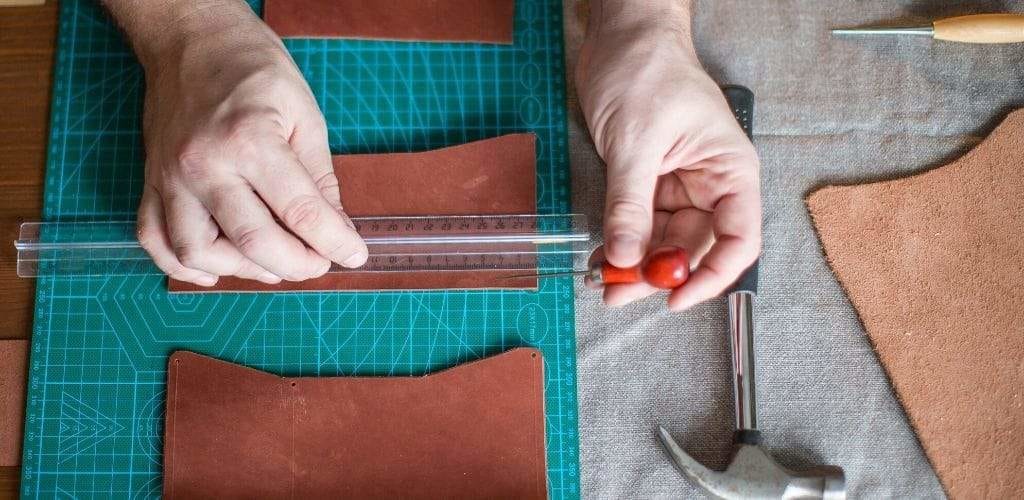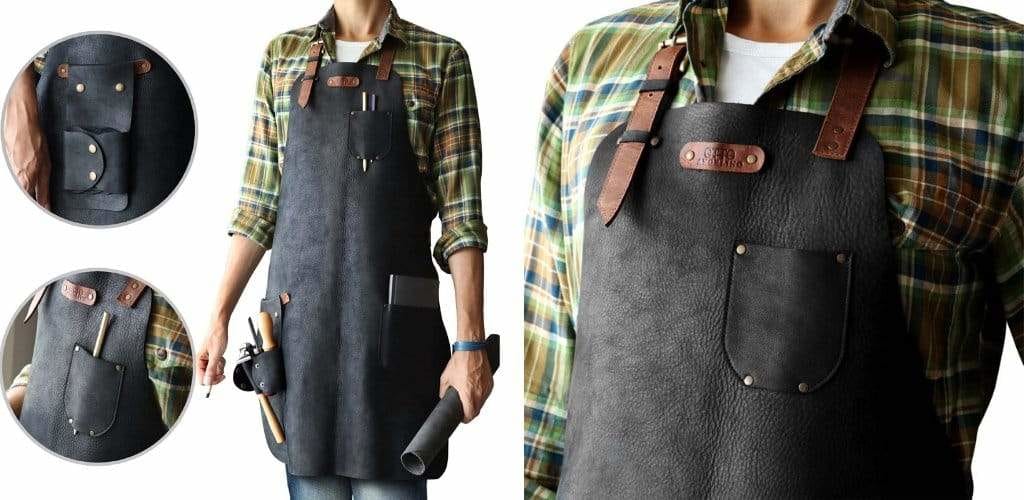Cleaning and Maintaining
The leather’s unique topcoat will protect it against spills and stains and make it easy to wipe off food and dirt. The apron should be dusted regularly with a clean, dry cloth. You can clean it with a damp, lukewarm cloth, using a mild non-detergent soap for stains, making sure you test it first in an inconspicuous area. Do not spot clean your leather apron; instead, clean the entire surface. Do not oversaturate the leather, and do not put the apron in your washing machine.
Harsh chemicals on the leather, including saddle soap, cleaning solvents, detergents, ammonia and furniture polish, should not be used on the leather apron.
If the leather becomes soaked, let it dry at room temperature. Do not place your leather apron on a heat source or use a blow dryer on it.
Your can maintain the apron using a leather conditioner made specifically for chromium-tanned leather. We recommend monthly conditioning. Make sure to wipe the apron with a clean cloth after applying conditioner.
Storing and Traveling
Your leather apron should be kept out of direct sunlight. When not in use, your leather apron should be hung on a hook or hanger. This will help it retain its natural shape. Folding might result in crack or crease marks. To pack your apron for travel, gently roll it from bottom to top.
About Leather Aprons

History
The word “apron” is derived from “naperon,” the French word for small tablecloth. The classic “bib” apron (also known as a “barbecue apron” or “French chef’s apron) has been around for centuries. Originally made from scraps of fabric, its clever design allowed it to be slipped over the head and tied at the back. It protected the front of the body while leaving the arms free, making it convenient and utilitarian. It was popular in Europe during the Middle Ages, worn by tradesmen including gardeners, furniture makers, leather smiths, cobblers, metal forgers, fishmongers, artisans and masons. At that time, it also became a domestic symbol associated with homemakers. Aprons were first considered fashion items in the Sixteenth Century. More recently, they became a cultural icon, a stylish accessory promoting health and nutrition and a symbol for a healthy family. Yet they also represented a symbol of sexism, the stereotype of the domestic goddess and stay-at-home mom. More recently, aprons are back in fashion as interest in cooking and crafts has become the norm.
Leather aprons also date back for centuries. Leather is an obvious choice of fabric due to its inherent beauty and elegance as well as its ability to withstand heat and flames and repel water, oil and dirt.
Aprons for Women
Commonly worn by women in the kitchen, it was originally a symbol of ideal domesticity. However, by the late Twentieth Century the apron was viewed through the lens of sexism, coming to represent constraint and imprisonment in the kitchen. During the 1960’s, when many women disliked the idea of being a housewife, aprons became to be seen as old-fashioned garments worn only by grandmothers. But because aprons remained important in the workplace, worn for functional reasons, cultural influences have resulted in a revival of the apron, spurred on by the kitchen and crafts movements, increased interest in cooking and renewed interest in retro fashions. Even vintage apron styles have become fashionable.
Aprons for Men
Originally worn by tradesmen – blacksmiths, butches, barbers, woodworkers, welders – today you are likely to see a male barista, a guy flipping burgers on the grill, or a waiter at an upscale restaurant sporting a leather apron. Industrial aprons protect men’s clothing from water, chemicals and dyes. Since modern men often take pride in their appearance and wear good quality shirts and pants, of course they want to protect their clothing. Today’s leather aprons are manly, rugged, form-fitting, handsome and stylish.
Types of Aprons
A bib apron typically slips over the head and ties around the waist, protecting the front of the body and leaving the arms free. Full-length leather aprons that go down to the mid-thigh or knees provide additional protection from sparks, heat and slag.
A bistro chef apron has a slit and is perfect for barbecue pit masters.
The waist or half apron is a traditional kitchen apron. It ties at the waist and goes down to mid-thigh. Originally used by maids and housewives, today it is popular among restaurants and bars personnel.
The pinafore, a relative of the apron and worn mainly by children, is usually adorned with ribbons, bows and ruffles. Featuring more fabric over the shoulders, it is more decorative than functional.
The bungalow apron was typically worn by housewives during the early part of the Twentieth Century. Typically unadorned, with kimono sleeves, it was worn as a stand-alone garment, not over clothing. Somewhere between a housecoat and a nightgown, it was used at home only.
The tabard apron covers both the front and back of the body and is fastened with side or waist ties. Used in the Middle Ages, it was originally worn by monks and peasants. Today you can see it on bakers and nurses. It covers just the upper part of the body.
Leather Choices for Aprons

Chromium-tanned leather is by far the best choice for apron material because leather made with chrome salts is as durable as, yet thinner and more flexible than, vegetable-tanned leather. Chromium-tanned leather is typically used for furniture and garments because it can be shaved to a thickness that allows for draping as well as for stitching needles to perforate. Oil-tanned hides are made using chromium, but are also infused with oils for preservation, resulting in slightly stiffer and heavier leather that is perfect for making an apron.
You should look for full-grain leather, the untouched top layer of the hide. The fibrous epidermis allows for greater penetration protection and longevity as well as a more natural look and feel. And finally, you want the leather to be thick, but not too firm or heavy, to allow for movement and flexibility. While garment leather is super-thin, weighing in at approximately 2 to 3 ounces per square foot, an apron should not feel flimsy, so 8 – 9 ounces is ideal (a little less than 1 millimeter thick).
In general, industrial aprons are typically made from durable and heavy-duty materials, making leather an excellent choice. Advances in tanning technique have made it possible to produce lighter-weight leather that maintains its tensile strength, resulting in the ability to use it for cooking aprons.
Apron Fit
Just like any item of clothing, your apron should fit your body. You don’t want to feel bound, squeezed or awkward. Ideally your apron will have adjustable straps, even if the apron itself is standard size. The less comfortable the apron, the less likely you are to wear it, so make sure it fits properly.
For comfort, look for wider straps or epaulets that help disburse the weight over a greater area. The apron should hug your body without interfering with or restricting your movements. Pockets and tool loops offer convenience. Fully adjustable straps will allow you to transition from winter clothing to summer clothing.
When using your apron for the first time, adjust the neck look first. The apron should cover the top of your clothing without being constraining. Next, cross the waist ties at your back and then tie them in a bow in front. Make sure the apron is tight enough to not interfere with your work but loose enough that you are comfortable.
Otto Angelino Leather Apron with Tool Pockets

Personalized Fine Leather Cooking, Barista, Workshop Apron with Tool Pockets
Product Description
The versatile Otto Angelino Leather Apron is crafted from high quality cowhide leather manufactured. Suitable for woodworkers, chefs, baristas, gardeners, cobblers and craftspeople of all types, the Otto Angelino is the preferred leather apron of men and women alike. Superbly crafted and amazingly comfortable, its many features offer a practical solution to working, while looking smart and fashionable.
Our multi-functional leather apron features luxuriously supple full-grain leather in a rich, dark brown, durable leather straps, hand stitching, convenient pockets and fashion-forward design. We chose the aniline-dyed, full grain leather for its perfect thickness – not too stiff and heavy to wear – as well as for its flexibility, with just the right balance to be comfortable, while affording mobility and protection.

The apron comes with an attachable leather knife roll and pouch, ingeniously designed to store everything from chef, garden and grilling utensils to knives and tools, all within easy reach. You can also personalize your apron with a name tag or have it monogrammed with your intitials. Made to last, the Otto Angelina Leather Apron will become more beautiful with use and age. In fact, it will develop a character as you continue to wear it, softening up and even molding to the shape of your body.
- Exquisite Leather Craftsmanship: Made from the finest leather and durable stitching, yet easy to maintain
- Heat Resistant: Inherently resistant to heat, flame and water
- Convenient: Designed with useful pockets and knife roll for work tools and accessories
- Adjustable: Adjustable leather neck and belt straps make it easy to fit any body
- Multi-Functional: Can be used as kitchen, chef, cooking, grilling, barista, garden, barber, workshop apron
- Unisex: Perfect for men and women




